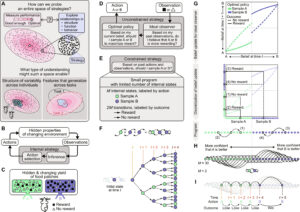Life flourished on Earth much earlier than previously thought, thriving under the harsh rule of … [+]
Earth formed about 4.5 billion years ago from dust and gas orbiting the young Sun, coalescing into a molten mass. This period marked the beginning of the Hadean Aeon, named after the Greek god of the underworld Hades, reflecting the hellish conditions prevailing at the time. The Hadean Eon lasted from about 4.5 to 4 billion years ago.
For decades, scientists believed that life on Earth arose long after the era of Hades’ rule, about 3.8 billion years ago. This was a hypothesis supported by the oldest known fossils dating from this period. This timeline was thought to correspond to the planet’s “cooling phase,” where conditions became suitable for life to take root and develop. However, this long-held belief has been deeply challenged by recent findings published in the journal Natural ecology and evolution.
The last universal common ancestor dates back almost to the dawn of the Earth itself
Earth formed from the accumulation of dust and gas, appearing as a burning sphere devoid of stable land masses or oceans. Initially, the surface was dominated by molten rock and the planet was frequently subjected to intense meteorite bombardments. This era, known as the Hadean Aeon, spanned a landscape so harsh that it seemed inhospitable to any form of life.
Like crème brûlée, as the Earth’s surface gradually cooled, the first solid crust began to form, paving the way for the accumulation of water vapor in the vast oceans and the rise of the protocontinents. At the end of the Hadean period and into the Archean eon, about 4 billion years ago, the Earth began to resemble its present form more, with the appearance of land masses and large bodies of water.
The Last Universal Common Ancestor, or LUCA, was found to have existed before that time, according to recent findings, at a time when Earth’s landscape was vastly different from today — a world still characterized by flowing lava and a nascent solid crust. That was 4.2 billion years ago.
How do we know this if there are no fossils surviving the Hadean eon?
Tracing life back to the Hadean Eon is a difficult task for scientists, mainly because traditional methods of archeology and paleontology rely on fossils that simply do not exist from that time. The Hadean Earth was so turbulent and hot that any biological material from that era would likely have been destroyed or never preserved.
However, by using advanced genetic and molecular techniques, rather than relying solely on physical fossils, scientists were able to circumvent these limitations and date LUCA more precisely.
Why this precise dating of LUCA is important
LUCA’s dating to 4.2 billion years ago, which extends the timeline of life on Earth 400 million years earlier than previous estimates of 3.8 billion years based on fossils, is very significant for several reasons.
- Rapid emergence of life. The revised chronology highlights how quickly life appeared after Earth formed. Given that Earth is about 4.5 billion years old and was initially largely molten, the emergence of life at 4.2 billion years suggests that life began soon after the planet’s environment became even minimally habitable. This rapid emergence suggests that the conditions necessary for life may be less stringent and more common in the universe than previously thought.
- Complexity of early life forms. The study’s new findings suggest that LUCA likely has a genome size of about 2.5 million base pairs, encoding about 2,600 proteins, similar to modern prokaryotes (simple, single-celled organisms without a nucleus, such as bacteria). The results also suggest that LUCA was a primitive, anaerobic organism capable of producing energy from acetogenesis (the process of converting hydrogen and carbon dioxide into energy) and had an early form of an immune system. The findings of LUCA possessing a rudimentary immune system suggest that early life not only managed to establish itself in harsh conditions, but also developed complex biological mechanisms early on. This challenges previous notions of primitive life as overly simple and highlights the inherent complexity that life has had almost from the beginning.
- Ancient evolutionary arms races. The existence of an ancestral immune system in LUCA was likely a crucial adaptation for fending off ancient viruses. This suggests that the evolutionary arms race between life forms and pathogens began almost immediately after the appearance of life itself, highlighting the constant struggle for survival and adaptation that has shaped the history of life on Earth.
- Geological and biological interactions. Advanced LUCA dating highlights the interplay between Earth’s evolving geology and emerging biology. The fact that life can thrive in such an unstable environment points to a more dynamic interplay between Earth’s physical transformations and the adaptability of life, changing our understanding of how planetary processes affect life.
- Implications for astrobiology. Knowing that life appeared so quickly on Earth and developed complex mechanisms such as an immune system in such a short geological time span expands the potential for life on other planets. This may adjust our criteria for habitable conditions and what to look for in the search for extraterrestrial life.
Essentially, this new LUCA dating doesn’t just add a few hundred million years to the age of life on Earth; it profoundly deepens our understanding of the resilience and complexity of life, changing the way we think about life both on Earth and throughout the cosmos.



